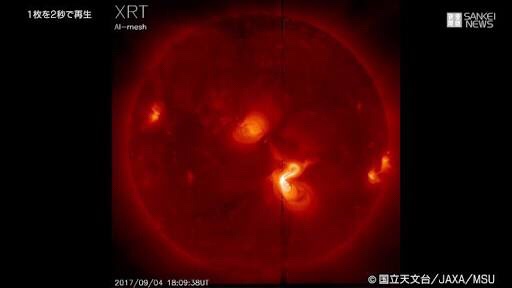
名古屋大:太陽フレア予測の新手法:発生条件を解明(動画):
Nagoya Univ: New method for solar flare predict: generation conditions:
名古屋大学:太阳耀斑预测的新方法:产生条件的阐明
名古屋大:
名古屋大などのチームが31日付の米科学誌サイエンスに発表した。
太陽フレアの発生条件解明:
太陽フレアは、停電や通信障害など社会生活に影響を及ぼします。
太陽表面で起こる爆発「太陽フレア」が発生する条件を解明し、巨大フレアが起きる位置や規模を正確に予測する手法を開発しました。
10年間データこの手法で分析:
過去10年間のデータをこの手法で分析した結果、
9回の巨大フレアのうち7回は前兆を捉えられたことが判明。
フレアを予測する「宇宙天気予報」の精度向上につながると期待される。
名古屋大の草野教授:(太陽地球環境物理学)
「まれにしか起こらない巨大フレアを予測する世界初の方法だ。社会に影響が出る前に対策を取れる」と話している。
共同通信
https://this.kiji.is/661629804554814561
A physics-based method that can predict imminent large solar flares Predicting large solar flares
The sudden release of magnetic energy on the Sun drives powerful solar flares, which are difficult to predict.
Kusano et al.
derived physics-based thresholds for the onset of large solar flares and show how they can be predicted from routine solar observations (see the Perspective by Veronig).
They tested their method using observations of the Sun from 2008 to 2019.
In most cases, the method
correctly identifies which regions will produce large flares within the next 20 hours, although there are some false positives and false negatives.
The method also provides the exact location where each flare will begin and limits on how powerful it will be.
Accurate predictions of solar flares could improve forecasts of space weather conditions around Earth.
Science, this issue p. 587; see also p. 504
Abstract
Solar flares
are highly energetic events in the Sun’s corona that affect Earth’s space weather.
The mechanism
that drives the onset of solar flares is unknown, hampering efforts to forecast them, which mostly rely on empirical methods.
We present the κ-scheme,
a physics-based model to predict large solar flares through a critical condition of magnetohydrodynamic instability, triggered by magnetic reconnection.
Analysis of the largest (X-class) flares from 2008 to 2019 (during solar cycle 24)
shows that the κ-scheme predicts most imminent large solar flares, with a small number of exceptions for confined flares.
We conclude that
magnetic twist flux density, close to a magnetic polarity inversion line on the solar surface, determines when and where solar flares may occur and how large they can be.
https://www.sciencemag.org/about/science-licenses-journal-article-reuse
Science